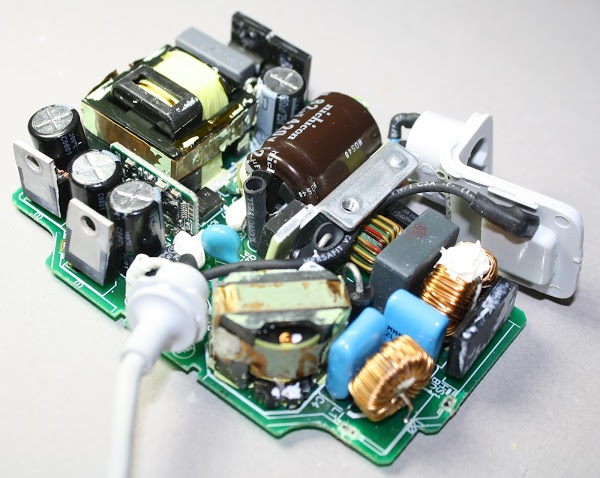
Almost every week we read a story about some unfortunate whose house has burned down because of faulty charger. In almost every case the fault lies not with the manufacturer of the phone or device but with the bargain after-market charger that the owner assumed would do the job. It doesn’t.
There’s a strong tendency, particularly among the untechnical, to underestimate what goes into a really safe charging device. The complexity of a safe charger often justifies the higher price and it is decidedly false economy to buy an unbranded and ridiculously cheap copy.
The case is illustrated by this picture of the innards of a MacBook charger. The glossy white plastic outer shell gives not a hint of what lies within. And, because of this, it is very easy to be seduced by something that looks the same but is a welcome fraction of the price. The fact is that this charger is a complex electronic component in its own right, with built-in protection against overheating, short-circuiting and plain misuse.
Righto.com is website that goes into detail about Lightning connectors, chargers and other peripherals that are often taken for granted. This article on the MacBook charger is a case in point and makes fascinating reading.

Other unwanted aspects of cheap chargers (aka power supply’s), are heat and an unstable and noisy output signal.
So if one is interested in audio at all, one will already appreciate these issues, along with those safety aspects that you mention Mike…
I have always regarded Apple’s power supplies with a level of disdain to be honest, even though I am an Apple user.
Naim Audio for instance have always separated their power supplies from their amplifiers, and what is more they are really expensive and well designed, and though I don’t have one any more, I never had any problem with that. The current price for their "entry level" HiCap is £1300, whilst their "signature" SSPSDR is £6235…
Another excellent British company that specialise in this area, are Linn, they virtually invented the "milled from a solid aluminium block" concept, back in the mid 1990’s, long before Apple or Leica, and used digital power supplies which they isolate within the same box… Also very expensive.